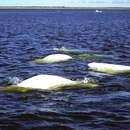Biology
provided by Arkive
Belugas are highly social animals, and in the summer months thousands of individuals can be seen gathered in estuaries; often females with calves will come together whilst males form large bachelor groups (3). Females are sexually mature at around five years of age, they give birth to a single calf after a gestation period that lasts just over a year (6). Mother and calf have an extremely strong bond, swimming very closely together, and the calf will continue to feed on its mothers milk until well into its second year (3). Belugas are able to dive to depths of over 1,000 metres but spend most of their time on the surface of the water swimming slowly. During winter months it may be necessary for individuals to create breathing holes in the ice, which they can do with their heavy head (7). The flippers are capable of a wide-range of movement and enable belugas to manoeuvre themselves effectively (3). In summer months, large numbers of belugas gather in estuaries in order to moult; they rub themselves on the gravel bed and shed the yellow, withered skin of the previous year to once again become gleaming white (3).
Belugas feed on a wide variety of fish, bottom-dwelling invertebrates and worms; most of the prey is found on the seabed and it is thought that the highly flexible lips may be used to suck prey into the mouth (8). Sounds can be used to detect prey; the enlarged melon is an electro-receptor for sounds that are sent out from the nasal passages (3). These whales are thought to live for up to 50 years, killer whales and polar bears prey upon them, and belugas are particularly vulnerable if trapped by the ice (6) (7).
Conservation
provided by Arkive
Today the widespread hunting of beluga whales is prohibited under the International Moratorium on Commercial Whaling (11); however, small quotas are permitted to local people who depend upon the harvest (6). The Alaska and Inuvialuit Beluga Whale Committee was established in 1988 and encourages dialogue between native hunters, conservationists and government representatives as well as carrying out stock and hunting assessment of the Alaskan and Canadian populations of belugas (12). Some protection from industrial development is being provided at locations where these whales commonly occur but careful monitoring of existing stocks will be needed to secure the future of this attractive cetacean (13).
Description
provided by Arkive
The snow-white beluga whale is one of the most distinctive of all cetaceans (a group that includes, dolphins, whales and porpoises). The stocky body ends in a particularly small head, and adults develop their striking white colouring as they mature (2). Belugas lack a dorsal fin, their genus name 'Delphinapterus' means 'dolphin-without-a-wing' (3) (6), but there is a ridge of toughened skin along the back that tends to be more pronounced in mature males (6). Unlike most cetaceans, belugas have an extremely flexible neck and can turn their head almost 90 degrees to the side; their lips are also flexible, forming a variety of facial expressions (3). Belugas use a wide range of vocalisations such as clicks, grunts, squeals, screeches and whistles (6). These sounds can be heard through the hulls of ships and the beluga was nicknamed the 'sea canary' by early Arctic sailors (3). They have a very thick layer of blubber which may be up to 15 centimetres thick that provides insulation in the freezing arctic waters (6).
Habitat
provided by Arkive
The beluga whale inhabits cold arctic waters, usually near to the ice edge (3). Summer is spent in shallow bays and estuaries, whereas in winter, the beluga whale occurs in areas of loose pack ice, where wind and ocean currents keeps cracks for breathing holes open (2).
Range
provided by Arkive
Belugas are found in Arctic waters around northern Russia, North America, Greenland and the Norwegian archipelago of Svalbard (3). Most populations migrate north in the spring, then south in the autumn once the ice starts to form (7).
Status
provided by Arkive
Classified as Near Threatened (NT) on the IUCN Red List (1). Listed on Appendix II of CITES (4), and listed on Appendix II of the Convention on Migratory Species (CMS or Bonn Convention) (5).
Threats
provided by Arkive
Belugas have traditionally been hunted for their blubber for many centuries, but only with the advent of commercial whaling did the harvest become too large to sustain (6) (9). These whales are particularly vulnerable, due to their high fidelity for certain migratory routes (3). Perhaps the most pertinent threat to the beluga today, is habitat deterioration in the form of the industrial development and pollution of coastal habitats with which they are particularly associated (3). Some populations are declining principally as a result of pollution; belugas in the St Lawrence River Estuary, for example, accumulate so many toxins that deformed calves are prevalent and dead individuals are treated as toxic waste (10).

